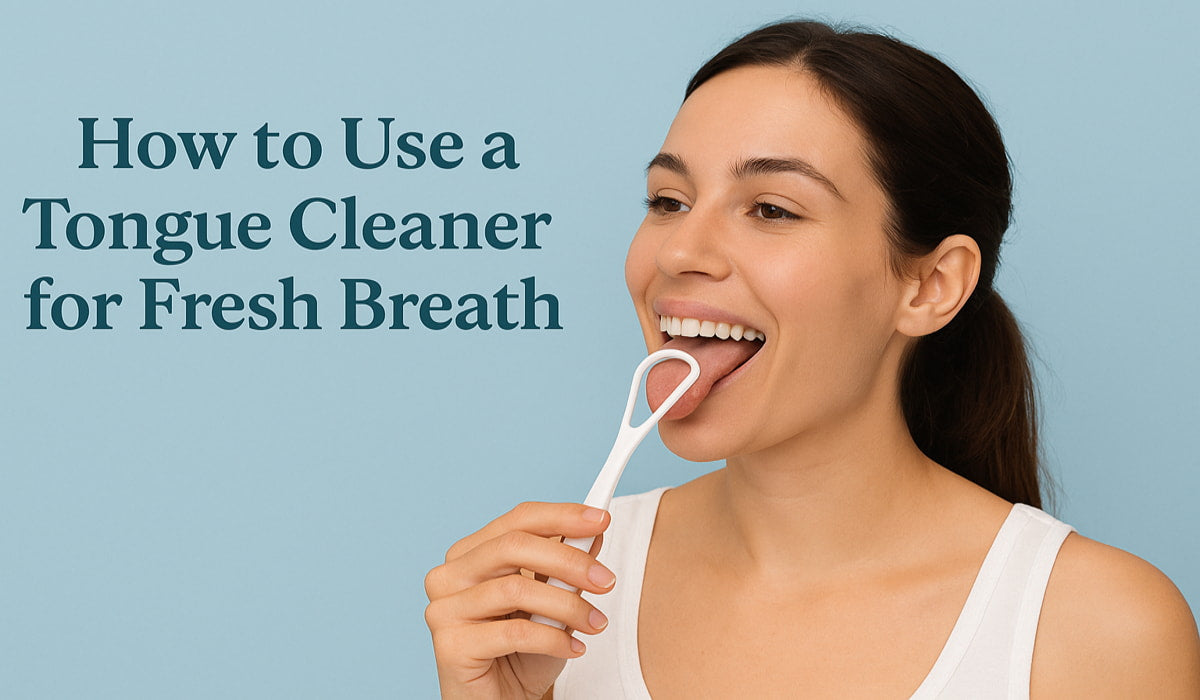Struggling with bad breath? Brushing and flossing aren’t always enough. One of the most overlooked tools in oral care is the humble tongue cleaner, and it might just be the secret weapon you’re missing.
Using a tongue cleaner for fresh breath is quick, simple, and surprisingly effective. It helps remove odour-causing bacteria, improves your sense of taste, and supports a healthier mouth overall.
In this guide, we’ll show you exactly how to use a tongue cleaner, why it works so well, and how to choose the best one for your needs, so you can enjoy fresher breath with minimal effort.
Why Cleaning Your Tongue Matters
Your tongue is home to thousands of tiny bumps known as papillae, which easily trap food particles, dead cells, and bacteria.
These microbes release volatile sulphur compounds (VSCs), which are the main culprits behind unpleasant breath.
Even if you brush your teeth religiously, ignoring your tongue can leave a large portion of your oral bacteria untouched.
A tongue cleaner or tongue scraper helps remove this coating, reducing odour and improving overall oral health.
Benefits of Using a Tongue Cleaner
It’s not just about fresh breath. Using a tongue cleaner can do more for your mouth than you might think.
-
Reduces bad breath by eliminating odour-causing bacteria
-
Improves sense of taste by clearing the film on your tongue
-
Enhances oral hygiene by lowering the risk of tooth decay and gum disease
-
Complements brushing and flossing for a more complete clean
Types of Tongue Cleaners Available in Australia
Before diving into technique, let’s look at the common types of tongue cleaners available in the Australian market:
1. Stainless Steel or Copper Scrapers
These are reusable, eco-friendly and highly effective. Copper also has natural antimicrobial properties.
2. Plastic Tongue Scrapers
Lightweight and affordable. While not as durable as metal, they’re gentle and easy to use.
3. Brush-Scraper Combos
These feature a small brush on one side and a scraper on the other. Some toothbrushes even have built-in tongue scrubbers on the back of the head.
BreezeCare offers high-quality tongue cleaners designed to support fresher breath and better oral hygiene. Explore and find the one that works best for you.
How to Use a Tongue Cleaner — Step-by-Step
Using a tongue scraper may feel a bit strange at first, but it only takes a few seconds and can make a huge difference.
Step 1: Brush and Floss First
Always start by brushing your teeth and flossing to remove food debris and plaque. This gives your tongue cleaner a clean field to work on.
Step 2: Stick Out Your Tongue
Stand in front of a mirror. Extend your tongue as far as is comfortable. This gives you full access to the surface.
Step 3: Place the Scraper at the Back of Your Tongue
Gently place the scraper as far back on your tongue as you can without gagging. You’ll get better with practice.
Step 4: Apply Light Pressure and Pull Forward
Scrape from the back of your tongue to the tip in one smooth motion. Don’t press too hard. Light, firm strokes are enough to remove the coating.
Step 5: Rinse and Repeat
Rinse the scraper under warm water and repeat 2–3 times until the tongue looks clean and pink. If you’re using a brush-style cleaner, gently scrub and rinse.
Step 6: Rinse Your Mouth
After scraping, rinse your mouth with water or a non-alcoholic mouthwash to flush away loosened debris.
How Often Should You Clean Your Tongue?
You should clean your tongue twice a day, ideally after brushing your teeth in the morning and before bed. However, once daily is still beneficial if you’re short on time.
What’s the White Coating on My Tongue?
That white or yellowish coating is a mix of bacteria, dead cells and food debris, and it’s often the main cause of halitosis. Regular tongue cleaning helps prevent this buildup, especially for smokers or people with dry mouth.
Tips for Best Results
Want to get the most out of your tongue cleaning routine? Here are a few simple habits that can make a big difference in keeping your mouth feeling fresh and healthy:
-
Use a high-quality tongue scraper — Stainless steel or copper models are durable and easy to clean.
-
Clean the scraper after every use — Rinse thoroughly or use antibacterial soap.
-
Avoid scraping too hard — Over-scraping can irritate or damage your tongue.
-
Pair with alcohol-free mouthwash — This helps maintain a balanced oral environment.
What If My Tongue Bleeds or Hurts?
Mild sensitivity at first is normal, especially if you've never cleaned your tongue before. However, bleeding, pain or ulcers could signal improper technique or an underlying issue. If symptoms persist, consult your dentist or oral health professional.
Who Should Avoid Tongue Cleaning?
Most people can benefit from tongue cleaning, but if you have any of the following, it’s best to check with a healthcare provider first:
-
Open wounds, ulcers or oral thrush
-
Post-surgery conditions
-
Certain medical implants
Tongue Cleaners vs Toothbrush Scrubbing: What’s Better?
Some people use their toothbrush to scrub the tongue. While it’s better than nothing, studies show that tongue scrapers are far more effective at removing the thick bacterial layer and reducing bad breath.
Toothbrush bristles can push debris around rather than lift it away, and they’re not designed to contour the shape of the tongue.
How Tongue Cleaning Helps With Other Oral Conditions
Using a tongue cleaner can support your overall oral health routine by:
-
Reducing risk of gum disease
-
Minimising plaque buildup
-
Lowering the chances of tonsil stones
-
Improving digestion
While not a cure-all, tongue cleaning complements other oral hygiene habits for long-term results.
Fresh Breath Starts With a Clean Tongue
At BreezeCare, we’ve spent years educating Australians about the importance of fresh breath, not just for social confidence but for long-term wellbeing. Tongue cleaning is a simple yet powerful habit to help:
-
Prevent chronic bad breath
-
Improve your quality of life
-
Support other oral health products like mouthwashes, gels and dry mouth treatments
Final Thoughts
A tongue cleaner might seem like a minor addition to your dental care routine, but it can have major effects. By removing bacteria and debris trapped on your tongue, you can prevent bad breath, enhance your oral health and even enjoy your food more.
Whether you choose a copper scraper, a plastic tool or a dual-action brush, the key is consistency and proper technique. Your mouth and everyone around you will thank you.
Browse Fresh Breath Solutions at Breezecare Oral Health
At BreezeCare, we offer a wide range of clinically proven solutions for fresh breath, including tongue cleaners, antibacterial mouth rinses and dry mouth treatments. Explore our full range or speak to our experts today.











